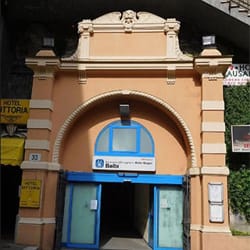Well, today I made everyone’s lunch at my workplace. By which I mean that, at Paracas Museum, where I work, we all make lunch together and we all eat together. Paracas Museum is a building that stands alone in this world of sand in a nature reserve, so there are no nearby diners or restaurants, you can’t just pop out to enjoy a meal, and that’s how this practice came about. Today I made short pasta with loads of vegetables, like tomato, onion, garlic, carrot, and spinach, as well as bacon. Everyone liked it, but as you would expect, it was quite difficult to prepare 8 servings in one go. That’s because in this place 8 servings means boiling 1.5 kg of short pasta. When you lift out the pasta from the pot into the colander, it is quite a difficult operation to make sure there is no unevenness between the top and the bottom of the colander in terms of the firmness of the pasta.

Logically, 1.5 kg divided by 8 makes 187.5 g per serving. Isn’t that way too much? A certain well-known Japanese cooking website says that it’s 90-100 g per serving for long pasta, and 60-70 g per serving for short pasta. I have discovered just how different the idea of one serving is in Japan and Peru. When you eat out in Peru, I recommend that you order your meal with that fact in mind. Even now, 6 months after arriving, when I’m hungry and go out to eat, I sometimes end up making the mistake of ordering an amount of food that I absolutely cannot eat up. It’s pretty tough figuring out how to live your life.
Well, so far, I’ve talked about this and that, but everyone sits around a single table, and the conversation gently unfolds as we eat lunch. I think this custom is pretty good. I really like it. It really is a case of “Onaji kama no meshi wo kuu” (literally “Eating rice from the same pot,” or “Living under the same roof”). By the way, the Spanish word “compañía” (“company”) is made up of “com” (“together”) plus “panis” (“bread”). So, it means something like “the ones with whom you share meals, partaking in bread with one another.” I’m not sure, but is that why the staff at Paracas Museum get along very well with each other? They’re like a happy family. I hope to get a bit more used to cooking 8 servings and treat everyone to something even tastier.

Recently I have taken the lead on planning an event at Paracas Museum and in early May I started traveling with the museum director to the capital Lima for 6 training sessions at the Museo de Arte de San Marcos called “Proyectos educativos para el diálogo en museos” (“Educational projects for conversations in museums”).

What I have found really interesting about these workshops is that while in most educational programs, like the one I am planning at the museum, the people running the program plan the content in detail beforehand and then execute the plan, I am learning to think of the unforeseen events that crop up along the way as having great meaningfulness in the process, as well as how you can design, run, and evaluate/systematize the follow-up. The importance of “unforeseen events!!!” Doesn’t just hearing those words make you excited? In Lima, I have also had new encounters that might enrich my future life in Peru even more, so these days I’m realizing that you can’t open up new pathways unless you actively work at it.


I intend to tell you more about this program too as I go! So, here’s where I say “Adios!” This has been Shoko Yamamoto from Paracas, Peru.






























































